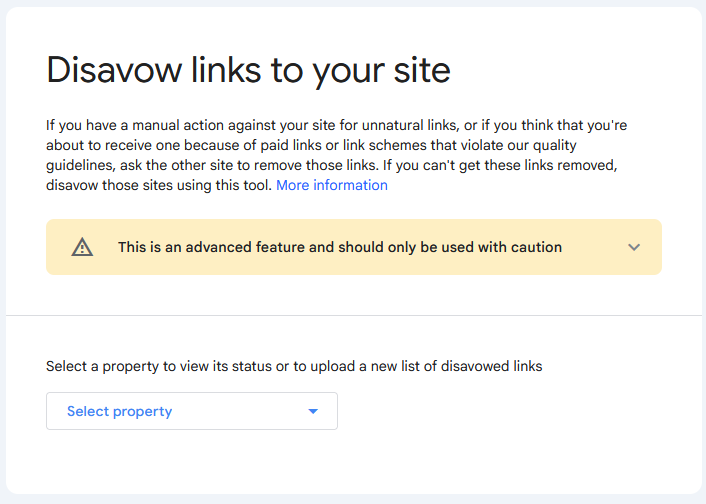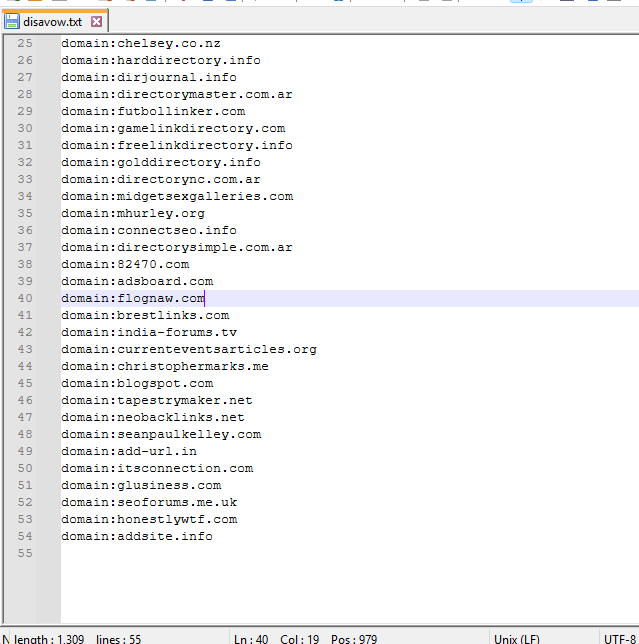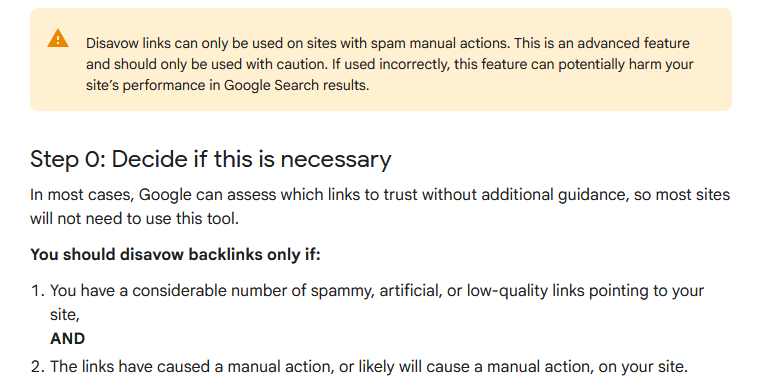I’ve used the disavow file three times in my SEO career. Two times to remove a manual penalty for domains we’ve acquired on behalf of a client, and once to lift an algorithmic penalty for a client. The latter one was for a local client in Calgary.
We used Google’s Disavow Tool as last resort to restore their rankings and keep ongoing seo/content efforts yield results.
What is Google’s Disavow Tool and how it might help your website?
The Disavow Tool was introduced by Google to help website owners notify its search engine algorithms to ignore selected inbound links from their weighted ranking calculations.

In simple English, incoming links(other websites linking to your domain) are counted as a ranking factor. Search engines through empirical data, have come to conclusion(patented technology) in the mid 00′, that people tend to link out to good content. Hence, links from relevant domains in your industry will improve your rankings and are seen as votes vouching for your website’s quality.
Contrary, “bad or toxic backlinks” are considered those coming from content farms, paid for link placements, linked with unnatural anchor text, buddy links (links exchange, you link to someone they link back), will demote your rankings as they’re manipulative in its nature(gaming the system).
Official search engine guidelines highly recommend to use this as last resort as this is an advanced feature. More on this later in the case study.
Who’s the local business website that we’ve helped?
We signed up CalgaryParging around mid of 2019. Rini the owner is an entrepreneur that has taught me about running a business more than I could imagine.
Working in SaaS before as an SEO Specialist with sophisticated marketing teams, you would think you’ve seen the peak of customer-centricity, but I never thought I’d learn the real meaning of customer obsession from a local stucco guy.
It’s a long story for another time, but their 340 Google reviews with a 4.9 average might give you a clue or two.
The mistake of using an offshore(non-Canadian) SEO agency
CalgaryParging came to us with the usual story. They hired an offshore SEO agency to work on their online visibility.
Fast forward for two years it yielded no meaningful results. A short-lived spike of keywords ranking on March 2018, after which the website traffic tanks and the offshore SEO agency goes dark.
It’s important to note that Calgary has talented SEO agencies in general, a reason more for businesses to use local instead of offshoring.
Countless hours in audits, improvements and diagnostics why the traffic drop
The SEO and the web design teams jumped immediately to re-design the website as it was built on Joomla CMS(outdated with less features).
A good website re-design, 404 (dead pages) cleanup, fixing internal broken links, new relevant internal links, schema markup, in 99% of cases yields quick positive SERP movements for a website.
After more than a quarter we didn’t see it happen in this case. Once the on-site seo and technical part was done, we did a surgical backlink audit. We were suspecting an algorithmic penalty, since the domain wasn’t slapped with a manual penalty. Whether a manual penalty exists or not, can be seen in Google’s Search Console.
Comprehensive Backlink Audit (Tools and Methods)
A backlink audit is the process of gathering all referring domains to evaluate their effectiveness and to find patterns of potential negative influence for a certain domain. This helps identify patterns and draw decisions on the nature of their placements, whether it’s organic or manipulative.
We used the following tools to map and aggregate all backlinks for our client’s website:
- Ahrefs
- Google Search Console
- Custom search engine scraping with operators and Scrapebox
From a list of little more than 100 referring domains that we scoped, we spent countless hours in vetting each and every one of them. It was symptomatic
How do toxic(bad) backlinks look like?
Our SEO team finalized a list of 50+ potentially harmful domains which linked unnaturally to our client’s website. The methods we used to shortlist potentially harmful incoming links to our client’s website, are obvious for a trained eye and they look like this:
- Spammy, generic directories (e.g. addsite.info or directorysimple.com.ar)
- Links from non-Canadian, generic forums (e.g. we found links from india-forums.tv)
- Links from domains registered and hosted for manipulative seo purposes (e.g. we found links from brestlinks.com or neobacklinks.com)
- Links from content farms (e.g. 123articlesonline.com) screenshot below.
- Links from non-moderated, adult and non-branded websites registered for most likely malicious intents ( e.g. 82470.com)

As you might see in the screenshot above, the link from now a disavowed domain (123articlesonline.com) is still accessible till today. This article links out to our client with over-optimized anchor text (under-lined, blue text in the screenshot).
How does the a disavow file look like?
A disavow file is simply a text file (.txt) that follows these formatting rules:
File type: plain text (.txt file) and it encodes in UTF-8. The encoding will be taken care of when you save as. UTF-8 will be there as an encoding option to save your file (at least in Windows).
The syntax rules:
If you want to disavow individual URLs (not on a domain level):
https://spamsite.com/the-url-linking-to-your-site/If you want to disavow on a domain level(any link coming from a particular domain):
domain:spamsite.comWe opted to disavow on a domain level for our local client in Calgary as didn’t see any user benefit for e.g. connectseo.info to link out to a local stucco business in Calgary on any of their pages frankly speaking.
It’s safe to claim that domains with ‘SEO’ in the name that aren’t agencies actually offering SEO services, but selling links, are the easiest to spot and shortlist for disavowing.
Our assumption (later proven right by search engines) was that the previous offshore SEO company was buying links left and right without worrying at least to acquire links from relevant domains such as home improvements websites.
Their black hat SEO footprint was easy to spot, which ultimately made this very important disavow decision more easy on us, and that we’re doing the right thing by disavowing these spammy backlinks.

Adding comments to the disavow text file is also possible. Something we like to use to further add context to this decision if someone manually goes over the file, is:
#Removed these links due to unnatural link pattern and links from link farms
domain:spamsite1.com
domain:spamsite2.com etcComments are optional, but it does add that additional context to anyone viewing that file.
Communicating the submission to the client
We made sure to communicate in details the underlying process and risks involved to our client. We assured them that we’re doing the right thing by showing them many samples of the URLs we’re about to disavow.
Showcasing other successful use cases of the Disavow Tool working helps instill trust while communicating the client, as well as official Disavow documentation from Google, made them further understand the whys & hows.
Like why in he world does the webmaster of ‘futbolllinker.com’ is linking out to their site the first place?
With that behind us, we started the submission process.
How to submit the disavow file – the process:
- Create the .txt file
- Go to Google Search Console ( you must have a gmail to open one)
- Navigate to Disavow Links tool
- Select your property (after you’ve verified your domain with Search Console you’ll see it listed here)
- Upload the file (the .txt file encoded in UTF-8)
The results and timeline post disavow file submission
The disavow file was submitted in the first quarter of 2020. Dopamine was hitting hard as we believed that the after effect will be positive. And Google didn’t disappoint.

After only three weeks to one month we started seeing search terms starting to trend up. This is dependant on how quickly search engines can crawl your disavow list of URLs and re-calculate your link profile weighted score.
Using an indexing service to speed up post-disavow results
Initially to speed things up, we used an indexing tool that can help ‘force’ Googlebot(the official Google crawler) to re-crawl the URLs from our Disavow text file instead of waiting for search engines to find those link which is a slower process.
In worst cases we would wait another 3 weeks (around 1.5 months). It was worth trying regardless, whatever that can speed up the process of recovery.
Once the disavow file kicked in we started seeing more notable movements after the 1-2 month. It came as relief and affirmation to our experience, that we’ve done the right decision by opting for the last resort. In the mean time we continued with primarly on-site and technical improvements such as:
- Previously, we re-designed the website with a fresh new theme on WordPress from Joomla.
- With the help of their seasoned stucco tradesmen we re-wrote the copy on the homepage and other service pages.
- Systemic meta data and image optimization.
- Systemic technical SEoptimization.
- We started publishing first-hand, educative and never seen before content.
One that we take big pride is “Stucco Trends, Pricing & Brand Popularity in Calgary“.
Regarding content, many SEO agencies will publish countless blog posts for small businesses that’s all fluff and rewrites! We didn’t want to compete with BobVila or other giants in the home improvement industry. We went for in-depth, qualitative data-driven blog posts for Calgarians. We aimed for quality not quantity… and Google followed with traffic!
This website now ranks for almost 200 keywords on the 1st and 2nd page and many local positions in Calgary with merit. Their stucco work is phenomenal and their customer support, close to none!
We couldn’t do it without the help of their seasoned stucco personnel.
They breathed life into our content strategy. A prime example of how a content strategy should be executed for a SMB operating in a city the size of Calgary. It’s not about writing everything under the sun. But that’s a case study for another time.
Lessons for Calgary businesses from this disavow process
Keep in mind that the disavow file was submitted by us roughly 5 years ago. Google has gone lightning years since then in terms of its ability to identify and discount bad backlinks. Bing went further by retiring their Disavow tool totally, back in 2023.
When to Use (and When NOT to Use) the Disavow Tool
The most crucial decision is early in the auditing process of a website. All onsite and technical issues should be remedied first, before resorting to disavowing potentially malicious inbound referring domains.
Next, for local websites in Calgary patterns in their backlink profile can be found easily as they don’t hoard big backlink profiles.
In other words, if your local business website has 100 referring domains from which for the sake of argument 60 look suspicious, an entry-level SEO should be able to differentiate between organic and artificially placed links with ease.
Ultimately it’s up to your SEO company in Calgary to recommend and you as the client on the receiving end of those services to decide for a disavow if such situation ever comes. This SHOULDN’T be a DIY SEO task, and we would never recommend a business owner in YYC without prior in-depth knowledge of how the Disavow Tool works to do a submission!
The TLDR is that, detecting a toxic backlink profile for a local business is much more easier compared to a international domain.
That will make the decision x10 easier.
Since 2020 we haven’t submitted any other disavow text file for any of our clients. Most of our clients have started and grown with Visibility Drip, so we’ve had some control over where their brand is mentioned or linked from. These are professionals, contractors, healthcare, fashion etc., in steady non-volatile niches/industries.
We doubt that the need to use the Disavow tool will ever rise again. Even Google now recommends submitting such file only when sites are hit with a manual penalty.

For volatile or highly competitive lucrative SEO industries where everything is ‘allowed’ (i.e. real-estate, healthcare, finance, online gambling, affiliate, crypto, or adult), most likely the disavow file would be used more frequently.

